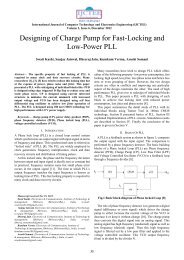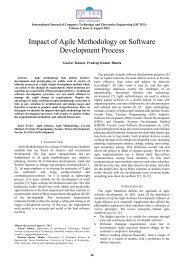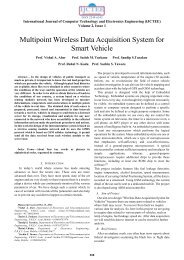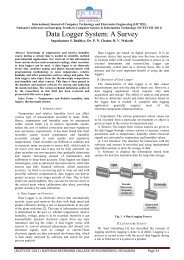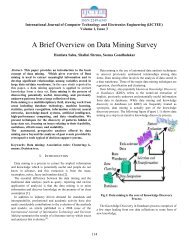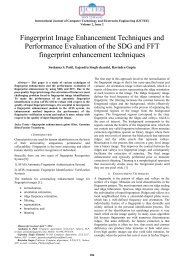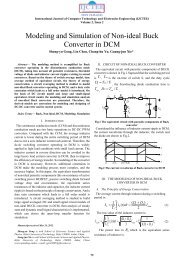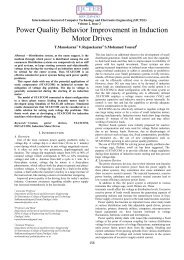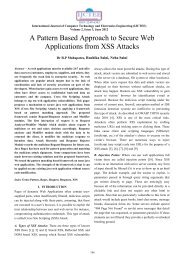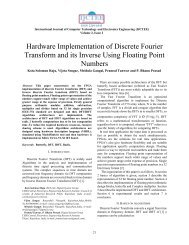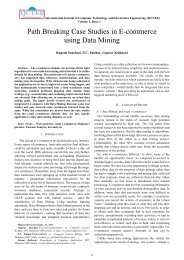Review Paper for Circular Microstrip Patch Antenna - International ...
Review Paper for Circular Microstrip Patch Antenna - International ...
Review Paper for Circular Microstrip Patch Antenna - International ...
Create successful ePaper yourself
Turn your PDF publications into a flip-book with our unique Google optimized e-Paper software.
ISSN 2249-6343<br />
<strong>International</strong> Journal of Computer Technology and Electronics Engineering (IJCTEE)<br />
Volume 1, Issue 3<br />
<strong>Review</strong> <strong>Paper</strong> <strong>for</strong> <strong>Circular</strong> <strong>Microstrip</strong> <strong>Patch</strong><br />
<strong>Antenna</strong><br />
Sonali Jain, Prof. Rajesh Nema<br />
<br />
Abstract- In this review paper a design of an per<strong>for</strong>mance<br />
analysis of FR-4 substrate <strong>for</strong> high frequency microstrip<br />
antenna and inset-fed dual frequency circular microstrip<br />
antenna rectangular slot <strong>for</strong> application in wireless<br />
communication and parasitically loaded CPW fed<br />
monopole antenna <strong>for</strong> broadband operation. The circular<br />
microstrip antenna resonates at 1.58 GHz and 2.43 GHz,<br />
which enables it’s usage in the wireless communication<br />
domain such as in Wireless Local Area Network<br />
(WLAN).By varying the lengths of the rectangular slot,<br />
the proposed antenna can provide a tunable frequency<br />
ratio of 1.50 to 1.62 <strong>for</strong> the two operating frequency band.<br />
The per<strong>for</strong>mance of a low-profile coplanar waveguide<br />
(CPW)-fed monopole antenna comprising of a straight<br />
strip, a parasitic circular-hat patch, and a slotted CPW<br />
ground <strong>for</strong> broadband operation is presented. A<br />
measured dual-frequency operation with a broad<br />
impedance bandwidth(10 dB return loss) of 77% from<br />
3.4–7.62 GHz, covering the required bandwidths of the<br />
lower operating band of the Japan’s ultrawideband<br />
(UWB), the 3.5/5.5 GHz WiMAX, and the 5.2/5.8 GHz<br />
WLAN standards,has finally been explored. Also, a stable<br />
monopole-like radiation pattern and an average antenna<br />
gain of 4.0 dBi across the operating band have been<br />
obtained.This work investigated the use of FR-4 substrate<br />
as a possible candidate <strong>for</strong> antenna design in the<br />
X-band.been designed at frequencies ranging from 2 to 10<br />
GHz.For this purpose single element microstrip antennas<br />
have The variations in the antenna per<strong>for</strong>mance due to<br />
frequency increase have been studied.<br />
Keywords- <strong>Microstrip</strong> <strong>Antenna</strong>, CPW, WiMAX<br />
I. INTRODUCTION<br />
<strong>Microstrip</strong> antennas have profound applications especially<br />
in the field of medical, military, mobile and satellite<br />
communications. Their utilization has become diverse<br />
because of their small size and light weight. Rapid and cost<br />
effective fabrication is especially important when it comes to<br />
the prototyping of antennas <strong>for</strong> their per<strong>for</strong>mance evaluation.<br />
As wireless applications require more and more bandwidth,<br />
the demand <strong>for</strong> wideband antennas operating at higher<br />
frequencies becomes inevitable. Inherently microstrip<br />
antennas have narrow bandwidth and low efficiency and their<br />
per<strong>for</strong>mance greatly depends on the substrate parameters i.e.<br />
its dielectric constant, uni<strong>for</strong>mity and loss tangent.<br />
.<br />
In this regard several comparative studies have been<br />
per<strong>for</strong>med e.g. in an Current study investigated the use of<br />
FR-4 substrate <strong>for</strong> microstrip antennas at different<br />
frequencies (2, 4, 6, 8and 10GHz) The rationale behind this<br />
research was to study the FR-4 substrate as a possible<br />
candidate <strong>for</strong> the design of microstrip antenna array in X-band<br />
and to satisfy simulated and measured results in close<br />
approximation. FR-4 has been chosen <strong>for</strong> this study because<br />
of its low cost and convenient availability hence can be used<br />
<strong>for</strong> microstrip antenna array prototyping. <strong>Microstrip</strong> patch<br />
antennas are attractive <strong>for</strong> their well-known efficient features<br />
such as compatibility with monolithic microwave integrated<br />
circuits (MMIC), light weight, less fragile, low profile etc.<br />
The main disadvantage associated with microstrip patch<br />
antennas is the narrow bandwidth, which is due to the<br />
resonant characteristics of the patch structure. But on the<br />
other hand modern communication systems, such as those <strong>for</strong><br />
wireless local area networks (WLAN), as well as emerging<br />
applications such as satellite links (vehicular, GPS,etc.) often<br />
require antennas with low cost and compactness, thus<br />
requiring planar technology. Due to the light weight of the<br />
microstrip patch antennas, they are appropriate <strong>for</strong> the<br />
systems to be mounted on the airborne plat<strong>for</strong>ms such as<br />
synthetic aperture radars (SAR) and scatterometers. Because<br />
of these applications of the microstrip patch antenna, a new<br />
motivation is evolved <strong>for</strong> research and development on<br />
indigenous solutions that overcome the bandwidth limitations<br />
of the patch antennas. In applications in which bandwidth<br />
enhancement is required <strong>for</strong> the operation of two separate<br />
subbands, an appropriate alternative to the broadening of the<br />
total bandwidth is represented by dual-frequency microstrip<br />
antenna, which exhibits a dual-resonant behavior in a single<br />
radiating element. In this paper, a simple dual-frequency<br />
inset-fed circular microstrip antenna with a rectangular slot<br />
<strong>for</strong> the application in the WLAN is proposed. The radius of<br />
the antenna is 25 mm.<br />
. In this communication, considering a slotted patch antenna<br />
fed by a CPW structure can exhibit broad bandwidth, lower<br />
dispersion, lower radiation loss, and in particular can also<br />
easily be integrated with a broadband fiber optical system, a<br />
simple and low-profile broadband CPW-fed monopole<br />
antenna with a parasitic circular-hat patch and a slotted<br />
ground plane simultaneously suitable <strong>for</strong> the Japan’s UWB<br />
lower band (3.4–4.8 GHz) operation, the 3.5/5.5<br />
GHz(3.4–3.69 GHz/5.25–5.85 GHz) WiMAX operation, and<br />
the 5.2/5.8GHz (5.15–5.35 GHz/5.725–5.825 GHz) WLAN<br />
operation is proposed.<br />
123
ISSN 2249-6343<br />
<strong>International</strong> Journal of Computer Technology and Electronics Engineering (IJCTEE)<br />
Volume 1, Issue 3<br />
Though the proposed antenna was initially conceptualized<br />
from referring the prototypes reported in works, we found that<br />
with use of a further simplified slotted-ground structure in the<br />
proposed design, the antenna, comparing to the already<br />
reported antennas with the similar function can effectively<br />
provide not only a much wider impedance bandwidth but also<br />
a larger size reduction.<br />
II. ANTENNA STRUCTURE AND DESIGN<br />
Shows the proposed antenna configuration. The basic<br />
antenna structure is a rectangle patch with dimensions (L×W)<br />
of printed on one side of a low-cost and easy-acquirement<br />
FR4 epoxy substrate with relative permittivity() 4.4 and<br />
substrate thickness 0.8 mm open-end circular ring slot and an<br />
inverted-U-shaped slot were embedded into the rectangle<br />
patch, and thus resemble the antenna structure as a CPW-fed<br />
strip monopole parasitically loaded with a circular-hat patch.<br />
Here, the used ring slot having an inner and an outer radius of<br />
r i and r 0 , respectively, was concentrically situated at the centre<br />
of the rectangle patch. The monopole element is a straight<br />
strip with dimensions of length L f and width W f , and has gap<br />
distances of d and s, respectively, to the ground and the<br />
circular-hat patch. For further improving the antenna’s<br />
matching condition, two horizontal short slots with the same<br />
size of L s ×W s were embedded into the ground’s left and right<br />
inner edges at the centre position along the vertical direction.<br />
The moment method code, IE3D, was used <strong>for</strong> required<br />
numerical analysis to examine the per<strong>for</strong>mance of the<br />
proposed antenna configurations in terms of achieving the<br />
broad bandwidth. Via iterative trials, dimensions of the<br />
antenna with good broadband operation were finally obtained<br />
and tabulated in Table I. Note that <strong>for</strong> the feeding portion the<br />
strip width of W f =2.2mm and gap distance of d=0.3mm were<br />
both obtained on leading to a characteristic impedance of 50<br />
Ω, whereas the length L f =15mm <strong>for</strong> the strip monopole was<br />
selected referring to the one-quarter wavelength of the desired<br />
operating frequency around 5 GHz.<br />
.<br />
This section describes design methodology <strong>for</strong> a circular<br />
microstrip antenna. The generic antenna layout highlighting<br />
the main design parameters and dimensions, where R is the<br />
radius of the circular patch, FR is the radius where the desired<br />
input impedance is calculated, L is the length and W is the<br />
width of the feed line. The feed line is a quarter-wave<br />
trans<strong>for</strong>mer to match the input impedance of the patch to 50<br />
ohm. The distance G between the radiating element edge and<br />
the ground edge is 0/4 according to [9].The commercially<br />
available FR-4 substrate was used in the antenna fabrication.<br />
These parameters are used in the design procedure <strong>for</strong><br />
determining the radius and input impedance of the circular<br />
patch antenna.<br />
Where Fr is the resonance frequency in Hz,ξ r is the<br />
substrate dielectric constant and h is the substrate thickness in<br />
cm. shows the geometry and configuration of a single<br />
frequency inset-fed circular microstrip antenna. The antenna<br />
(referred to as antenna 1 in this paper) was fabricated on an<br />
h=1.6 mm FR4 epoxy substrate with the dielectric constant<br />
ε r =4.4 and loss tangent tanδ=0.002. As shown in the figure, a<br />
microstrip transmission line is used to feed the circular<br />
microstrip antenna. The feed is inserted deep into the circular<br />
radiating element <strong>for</strong> the proper impedance matching. This<br />
arrangement <strong>for</strong> the feeding a microstrip antenna is known as<br />
the “inset-feeding”. The electromagnetic software IE3D is<br />
employed to per<strong>for</strong>m the design and optimization process.<br />
The design parameters are W=75 mm, L=80 mm, n =37 mm,<br />
g=1.0 mm, w f =3.05 mm and R=25. The inset length of the<br />
microstrip feed line is fixed at n=37 mm, which is 1.48<br />
times(1.48R) of the radius of the circular microstrip antenna.<br />
Fig1-Geometry of the proposed broadband CPW-fed monopole<br />
antenna with parasitic load.<br />
124
ISSN 2249-6343<br />
<strong>International</strong> Journal of Computer Technology and Electronics Engineering (IJCTEE)<br />
Volume 1, Issue 3<br />
Fig:- Geometry of antenna<br />
III. RESULT ANALYSIS<br />
The VSWR characteristics of the antenna 1. The value of<br />
VSWR at the first resonance frequency 1.61 GHz is 1.10.<br />
This depicts that there is good impedance matching between<br />
inset-fed microstrip transmission line and the circular<br />
radiating element in the frequency band from 1.59 GHz to<br />
1.64 GHz. From the Fig. 4 the variation of the input<br />
impedance versus frequency of the inset-fed circular<br />
microstrip antenna can be seen. At 1.61 GHz, the value of<br />
imaginary part (reactance) of the input impedance is almost<br />
0-Ώ and simultaneously the value of real part (resistance) is<br />
approximately 50-Ώ .Hence, from the graph it is clear that<br />
there is proper impedance matching occurs at the first<br />
resonance frequency i.e. at 1.61 GHz. In order to have a<br />
meaningful comparison between the simulated and measured<br />
results, the fabricated antennas are evaluated by extracting<br />
their S11. The simulated and measured data are over lapped in<br />
order to have better insight <strong>for</strong> comparison.<br />
TABLE 1:Literature <strong>Review</strong> Table<br />
Name Per<strong>for</strong>mance with a An Inset-fed<br />
analysis of Dual-Frequency<br />
FR-4 <strong>Circular</strong> <strong>Microstrip</strong><br />
substrate <strong>for</strong><br />
high<br />
<strong>Antenna</strong><br />
Rectangular Slot <strong>for</strong><br />
frequency Application in<br />
microstrip<br />
antenna<br />
Wireless<br />
Communication<br />
Parasitically<br />
Loaded<br />
CPW-Fed<br />
Monopole<br />
<strong>Antenna</strong> <strong>for</strong><br />
Broadband<br />
Operation<br />
Frequency<br />
2-10Ghz 1.584-2.43Ghz 3.4-7.62Ghz<br />
Bandwidth<br />
9.2 2.5-2.07 4.19<br />
Slot length 40.6mm 25mm 15mm<br />
Resonance<br />
Frequency<br />
10Ghz 2.42Ghz 7.62Ghz<br />
125
ISSN 2249-6343<br />
<strong>International</strong> Journal of Computer Technology and Electronics Engineering (IJCTEE)<br />
Volume 1, Issue 3<br />
IV. CONCLUSION<br />
This study provided an insight in determining the<br />
per<strong>for</strong>mance of microstrip patch antenna fabricated on FR-4<br />
substrate. From the results presented it is observed that FR-4<br />
can be used <strong>for</strong> X-band antenna designs. An<br />
inset-microstrip-line-fed dual-frequency circular microstrip<br />
antenna with a rectangular slot <strong>for</strong> using in wireless<br />
applications such as wireless local area network (WLAN) has<br />
been demonstrated. A novel low-profile broadband CPW-fed<br />
parasitic-loaded and slotted monopole antenna has been<br />
presented with theoretical and experimental results. The<br />
effects of existences of the parasitic element and the ground<br />
slots on both the antenna’s resonance and matching condition<br />
have also been investigated. This study provided an insight in<br />
determining the per<strong>for</strong>mance of microstrip patch antenna<br />
fabricated on FR-4 substrate. From the results presented it is<br />
observed that FR-4 can be used <strong>for</strong> X-band antenna designs.<br />
REFERENCES<br />
[1] A.Al-Zoubi, F. Yang, and A. Kishk, “A broadband center-fed circular<br />
patch-ring antenna with a monopole like radiation pattern,” IEEE<br />
Trans. <strong>Antenna</strong>s Propag., vol. 57, pp. 789–792, 2009.<br />
[2] V. P. Sarin, V. Deepu, C. K. Aanandan, P. Mohanan, and<br />
K.Vasudevan,“Wideband printed microstrip antenna <strong>for</strong> wireless<br />
communications,”IEEE <strong>Antenna</strong>s Wireless Propag. Lett., vol. 8, pp.<br />
779–781, 2009.<br />
[3] M. John and M. J. Ammann, “Wideband printed monopole design<br />
using a genetic algorithm,” IEEE <strong>Antenna</strong>s Wireless Propag. Lett.,<br />
vol.6, pp. 447–449, 2007.<br />
[4] S. K. Oh, H. S. Yoon, and S. O. Park, “A PIFA-type varactor-tunable<br />
slim antenna with a PIL patch feed <strong>for</strong> multiband applications,” IEEE<br />
<strong>Antenna</strong>s Wireless Propag. Lett., vol. 6, pp. 103–105, 2007.<br />
[5] C. H. Chang and K. L. Wong, “Printed -PIFA <strong>for</strong> penta-band WWAN<br />
operation in the mobile phone,” IEEE Trans. <strong>Antenna</strong>s Propag., vol.<br />
57, pp. 1373–1381, 2009.<br />
[6] Nasimuddin and Z. N. Chen, “Wideband multilayered microstrip<br />
antennas fed by coplanar waveguide-loop with and without via<br />
combinations,” IET Microw. <strong>Antenna</strong>s Propag., vol. 3, pp. 85–91,<br />
2009.<br />
[7] W. C. Liu, “Design of a multiband CPW-fed monopole antenna using a<br />
particle swarm optimization approach,” IEEE Trans. <strong>Antenna</strong>s<br />
Propag., vol. 53, pp. 3273–3279, 2005.<br />
126





